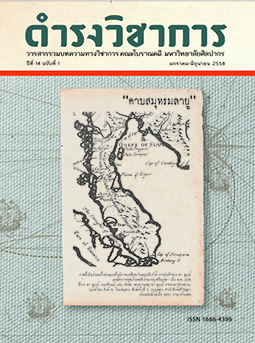“Textiles,” as the Mediums of Belief and Ritual: A Case Study of Na Meun Sri Textiles, Na Yong District, Trang Province
Keywords:
Textiles, Fabrics weaving, Local RitualAbstract
Clothes and textiles are materials which reflect human originality and creativity, especially domestic fabrics representing unique patterns, colors, and the production methods of each region. This is despite the same materials being used in the production of the fabric, which are either silk threads or cotton. Fabric weaving can, then, be regarded as one of the interesting aspects of the craftsmanship.
The discovery of pieces of textiles in various regions of Thailand can indicate the changes and movements of various cultures and groups of people as well as reflecting the social, cultural, political, and economic relationships between those people.
The initial research found that there are many interesting pieces of Southern textiles, which are Ratchawat fabric from Songkhla Province, Nakhon brocade from Nakhon Sri Thammarat, Pumriang fabric from Suratthani, and Juantani fabric from Pattani. While the previous research has covered the definition of the textile patterns, the decoration of the fabric on the body, and the representation of social status through clothes, there still needs to be more exploration of the issue of the roles of textiles in the context of local rituals.
The author’s interest in textiles and weaving has inspired the research of Na Meun Sri fabric from Nayong District, Trang Province. This type of textile has a connection to the rituals and the local people. The research focuses on the role of textiles as the “medium” connecting the world to the afterlife, the world to the holy, the world of the spirits to the world of earthly people, society, traditions, and culture through local ritual performance.
References
ขนิษฐา จุลบล, 2547. ผ้าถักทอคน...ผ่านคนทอผ้า “นาหมื่นศรี”. กรุงเทพฯ: สํานักงานกองทุนสนับสนุนการวิจัย (สกว.).
ชนัญ วงษ์วิภาค, 2540. ผ้าพื้นเมืองมอญ. กรุงเทพฯ: ห้องสมุดศูนย์มานุษยวิทยาสิรินธร (องค์การมหาชน).
ชวน เพชรแก้ว, 2558. สืบโยดสาวย่าน งานวิจัยวัฒนธรรมภาคใต้. เชียงใหม่: บลูมมิ่งครีเอชั่น.
วรรณา วุฒฑะกุล และยุรารัตน์ พันธุ์ยุรา, 2537. “ผ้าไทย.” ใน คณะอนุกรรมการส่งเสริมการแต่งกายแบบไทย (บรรณาธิการ).ผ้าทอกับวิถีชีวิตชาวไทย (หน้า 17-29). กรุงเทพฯ: สํานักงานคณะกรรมการวัฒนธรรมแห่งชาติ.
วิบูลย์ ลี้สุวรรณ, 2550. สารานุกรมผ้า เครื่องถักทอ. กรุงเทพฯ: ด่านสุทธาการพิมพ์.
สุนทรี สังข์อยุทธ์, 2548. ทอรักถักสายใย ผ่านลายผ้านาหมื่นศรี. กรุงเทพฯ: สํานักงานกองทุนสนับสนุนการวิจัย (สกว.).
สุริยา สมุทคุปติ์ และคณะ, 2537. แม่ญิงต้องต่ำหูก: พัฒนาการของกระบวนการทอผ้าและการเปลี่ยนแปลงบทบาทของผู้หญิงในหมู่บ้านอีสานปัจจุบัน. นครราชสีมา: ห้องไทยศึกษานิทัศน์ สํานักวิชาเทคโนโลยีสังคม มหาวิทยาลัยเทคโนโลยีสุรนารี.
อัญชลี ทองคง, 2553. การดํารงอยู่ของผ้าทอนาหมื่นศรีในสังคมทันสมัย. สารนิพนธ์ปริญญาศิลปศาสตร มหาบัณฑิต สาขาวิชาพัฒนามนุษย์และสังคม คณะศิลปศาสตร์ มหาวิทยาลัยสงขลานครินทร์, สงขลา.
อุบลศรี อรรถพันธุ์ และซัลมา วงศ์ศุภรานันต์, 2540. ผ้าทอพื้นบ้านภาคใต้. สงขลา: สถาบันทักษิณคดีศึกษา มหาวิทยาลัยทักษิณ.
Conway S., 1992. Thai Textiles. Bangkok: River Book Press.
Sakya A.M., 1994. Rites of Passage: A Comparison of Thailand and Nepal. Cambridge: Christ’s College.
Downloads
Issue
Section
License
บทความนี้เป็นผลงานของข้าพเจ้าแต่เพียงผู้เดียว และ/หรือเป็นผลงานของข้าพเจ้าและผู้ร่วมงาน ตามชื่อที่ระบุในบทความจริง และเป็นผลงานที่มิได้ถูกนำเสนอหรือตีพิมพ์ที่ใดมาก่อน





